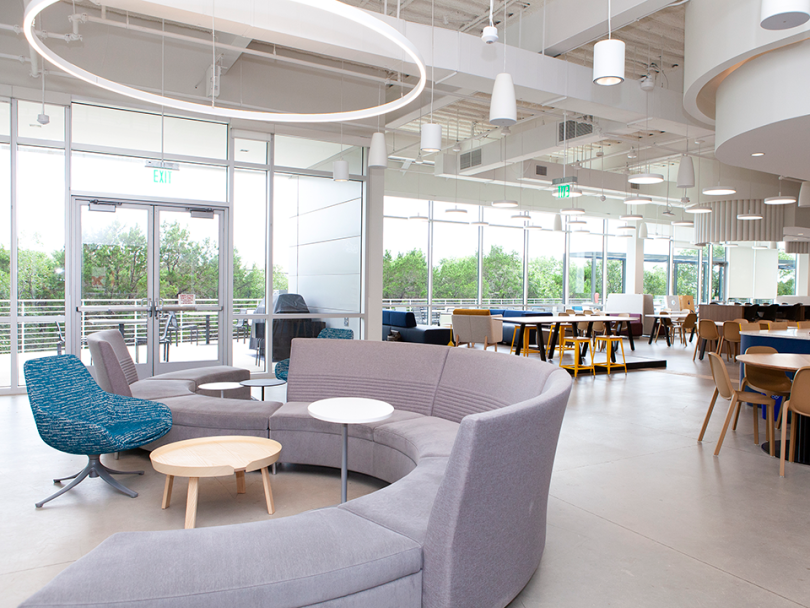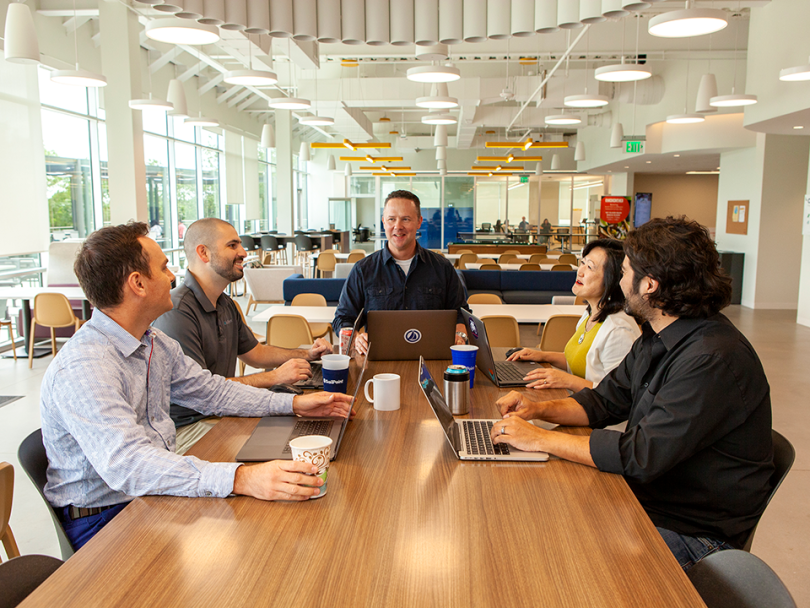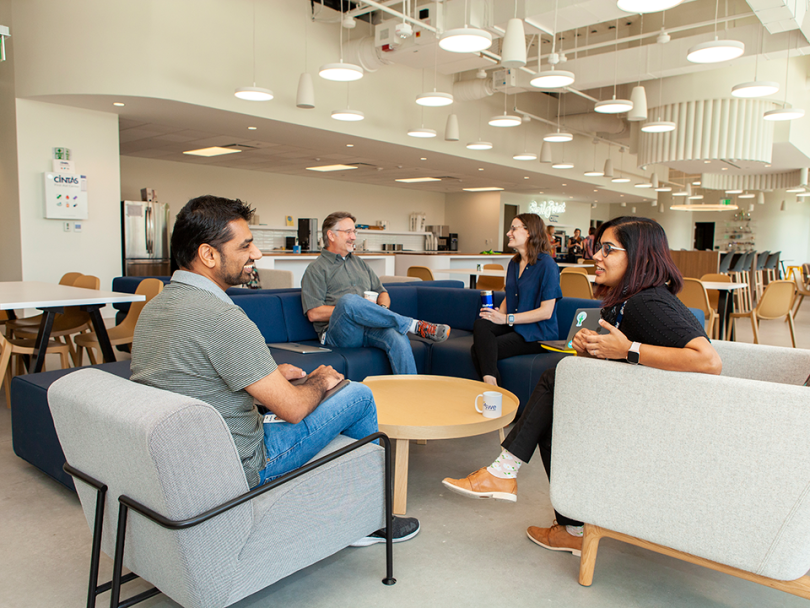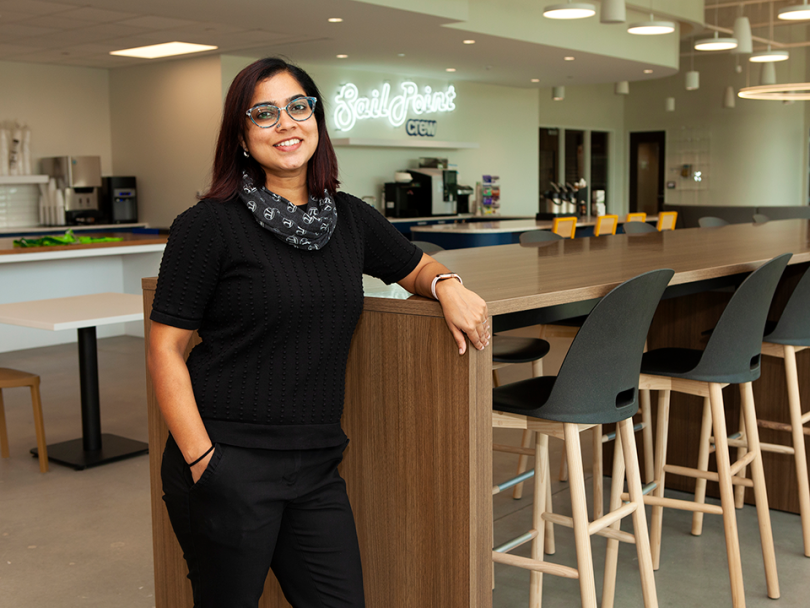For nearly 15 years, Austin-based SailPoint has led the identity governance industry in making it easier for enterprises across the world to manage and assign access controls.
While their award-winning technology is worth noting, behind it is a highly technical and talented team of product experts and engineers collaborating under a design-first mentality that involves co-creating with their end users.
Curious to learn more, we caught up with three members of their team.



FOUNDED: 2005
EMPLOYEES: 1,000+ globally
WHAT THEY DO: SailPoint’s identity governance platform helps companies understand who has access to what applications and data; determine who should have access; and understand how this access is being used.
WHERE THEY DO IT: Northwest Austin
STOCK UP: SailPoint, a public company since 2017, offers employees the chance to participate in an employee stock purchase plan (ESPP).
BALANCE ENCOURAGED: Understanding the importance of outside-of-work obligations, SailPoint provides a flexible working policy and unlimited PTO.
INSPIRING INNOVATION: In addition to hosting internal hackathons, the company provides an annual budget for engineers to attend industry conferences. Regularly scheduled lunch-and-learns are also available for teams to share their work with a broader audience.


Charles Poff, Chief Information Security Officer
Overseeing the security of a security company carries quite a bit of weight, but fortunately, Charles is up to the task. To ensure SailPoint remains as the leader in identity governance, he and his team operate in a continual world of building. This promotes a highly adaptive, responsive environment to deal with risks.
TWO WHEELIN’: Charles, quite the outdoorsman, enjoys fishing and riding dirt bikes in his free time.
How is your team working to evolve SailPoint’s product? What was that latest feature or iteration you helped develop?
Our security practices are always evolving with a focus on protecting our customers. The security team does not necessarily develop features as opposed to developing capabilities that allow us to act fast or to be more proactive. Two principles that we live by is to be holistic with any security design and to be proactive in our response capabilities. The days of just reviewing security logs and reacting are long gone.
What’s next for your team? What kind of growth is ahead, and who do you need to help your team get there?
I think what is next for my team is better innovation around automation, orchestration and predictive analytics as it pertains to security. I see growth around security operations and incident response capabilities and providing more intelligence versus event-driven data. We need to help facilitate and support strong foundational grounds for security operations, engineering and architecture, and find better ways to integrate into our platform.
Two principles that we live by is to be holistic with any security design and to be proactive in our response capabilities.”
Where do you see you SailPoint in six months? In one year?
I see our security function evolving to being more integrated with the product. We are continuing to make investments into our security program that will help us scale while being adaptive around our security posture. I see us shifting to a more development/security/operations skill set and aligning more with the Agile development processes and integrations.


Suchitra Hari, Engineering Manager, IdentityNow
Suchitra managers a group of UI engineers who work on SailPoint’s cloud-based IdentityNow platform to make it intuitive and delightful for users. She joined the company one year ago from IBM, calling it one of her “best career decisions.”
DANCE MOM: In addition to being a self-described “Potterhead,” Suchitra is trained in classical Indian dance forms and, most of all, enjoys spending time with her two kids, be it soccer, silly songs and mud puddles.
What specific projects on IdentityNow have you worked on and led, and how has this impacted the overall product?
As part of our “design first” methodology to engineering, my team and I have co-created with our end users through investing time in user-research, playbacks and early access and beta programs. Some product features that I am extremely proud of include the Dynamic Discovery Engine and governance-based Dynamic Separation of Duties, Certifications.
We’ve also invested in a cross-product common widget library of UI components we call Armada, which has resulted in the shipping of numerous features including brand new end-user dashboards, password reset experience, and access request and approvals.
Our new feature work almost always begins with a user story driven by our product team. We believe in ‘Fail fast, learn often.’”
How does your team collaborate with other teams across products?
The cross-product common widget library mentioned above, Armada, was the result of a group effort across my engineering team members and our UX designers. Armada's goal is to produce generalized modules, product characteristics and code snippets to foster consistency, efficiency and scale across our product portfolio. One of the best cross-product efforts that played out in action in recent times was introducing the data grid component in Armada. It was work that involved heavy collaboration between our File Access Manager team based out of Israel, our design lead, Liam Kendall, based out of Canada, and the IdentityNow engineering team in Austin.
From start to finish, what’s your process for creating or building out a new feature?
Our new feature work almost always begins with a user story driven by our product team. We believe in “fail fast, learn often.” This user story goes through refinement via feedback from customers and other stakeholders in collaboration with the design team. More often than not, we follow a phased approach to delivery to validate hypothesis and value proposition and refine features as we go along from early access to beta and then to general availability.


Michelle Rascati, Data Engineer
What do you get when you task a software engineer with building solutions designed for data wizards? You get Michelle’s role. As a data engineer, she teams up with SailPoint’s data scientists to build in-house solutions that turn their ideas and prototypes into production software.
ON BELAY: Not a fan of boring, repetitive workouts, Michelle opts for something a bit more challenging and fun: rock climbing. It’s one of her favorite ways to stay fit.
What were you most looking forward to from a technological standpoint when you first joined SailPoint nearly a year ago?
Being able to influence the foundation of a newer team. Although SailPoint has been around for almost 15 years, the AI and machine learning team is relatively young. The team I came from had already established a lot of the machine learning infrastructure before I started, so I was excited to bring that experience and start fresh with my own ideas and new technologies.
Since I started in October, our team size has more than doubled, as we’ve literally doubled-down on working to provide SailPoint Predictive Identity solutions.”
What is SailPoint Predictive Identity? How does it impact SailPoint’s existing solutions?
The SailPoint Predictive Identity team applies machine learning and AI techniques to provide our customers with valuable insight into their existing identity products. By using “supervised” machine learning in our recommendation system, we can identify the subtleties of what access should be approved or denied. With “unsupervised” machine learning techniques, we can also easily identify existing groupings of identities to recommend roles or detect suspicious outliers.
How big is your team, and how has it grown since you started?
We have about 20-plus people working on our AI and machine learning products. This includes data science, quality assurance and smaller groups of people working on specialized pieces of the product. My group of four works on the solutions directly related to data science. We work closely with another group of four that manages the “big data” we need. Another group of four combines the data and AI solutions to provide the applications that our customers ultimately interact with. Since I started in October, our team size has more than doubled, as we’ve literally doubled-down on working to provide SailPoint Predictive Identity-driven solutions.




